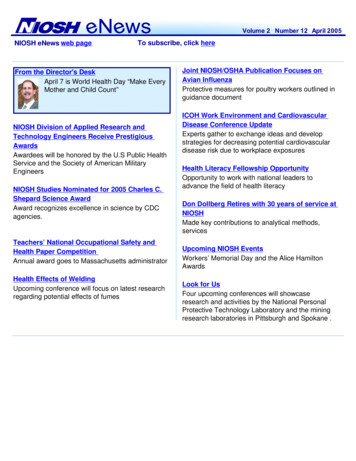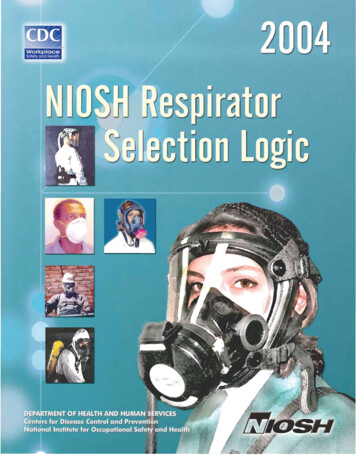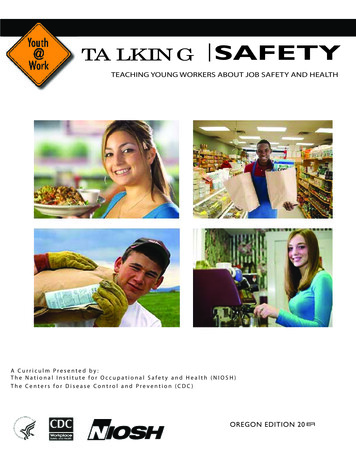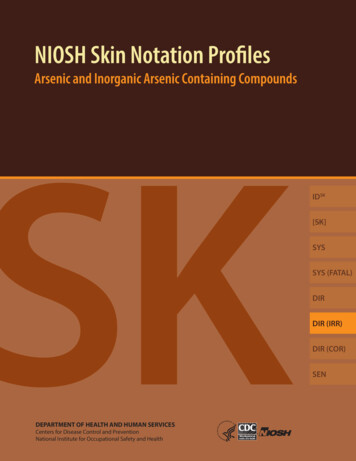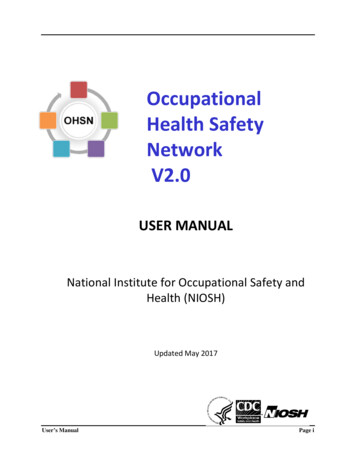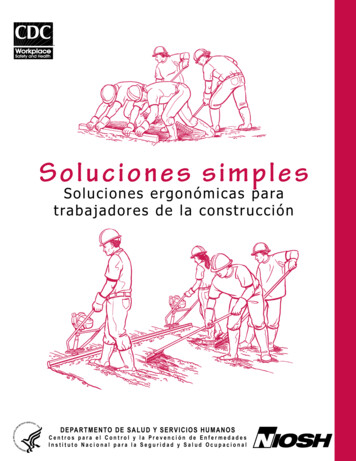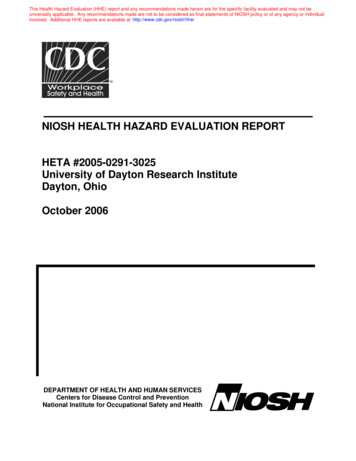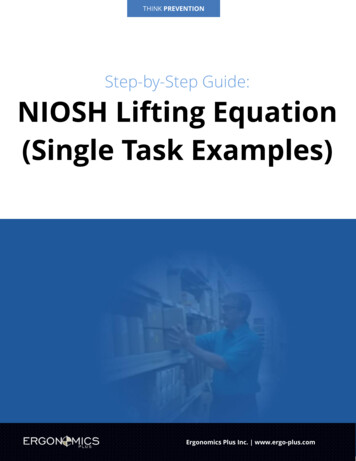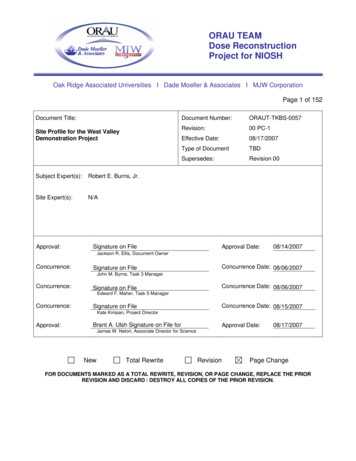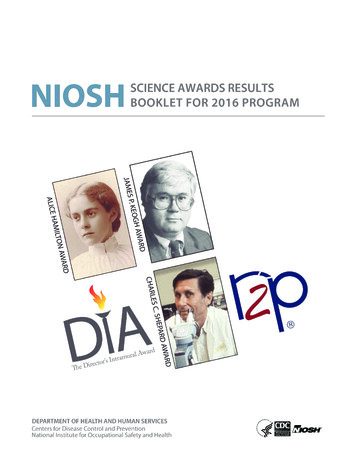
Transcription
Cover: The images on the cover of the NIOSH Science Awards Results Booklet for2016 represent the five NIOSH Scientific Awards presented annually.Top, left: photo of Alice Hamilton, representing the Alice Hamilton Awardsfor Occupational Safety and HealthTop, right: photo of James P. Keogh, representing the James P. Keogh Awardfor Outstanding Service in Occupational Safety and HealthBottom, left: logo for the Director's Intramural Awards for ExtraordinaryScienceBottom row, middle: photo of Charles C. Shepard, representing the Charles C.Shepard Science AwardBottom row, right: logo for the Bullard-Sherwood Research-to-PracticeAward
NIOSH ScienceAwards 2015DEPARTMENT OF HEALTH AND HUMAN SERVICESCenters for Disease Control and PreventionNational Institute for Occupational Safety and Health
is document is in the public domain and may be freely copied or reprinted.DisclaimerMention of any company or product does not constitute endorsement by the NationalInstitute for Occupational Safety and Health (NIOSH). In addition, citations to websitesexternal to NIOSH do not constitute NIOSH endorsement of the sponsoringorganizations or their programs or products. Furthermore, NIOSH is not responsible forthe content of these websites. All Web addresses referenced in this document wereaccessible as of the publication date.Ordering InformationTo receive documents or other information about occupational safety and health topics,contact NIOSH atTelephone: 1-800-CDC-INFO (1-800-232-4636)TTY: 1-888-232-6348CDC INFO: cdcinfo@cdc.govor visit the NIOSH website at www.cdc.gov/niosh.For a monthly update on news at NIOSH, subscribe to NIOSH eNews by visitingwww.cdc.gov/niosh/eNews.Safer Healthier PeopleTM 2 NIOSH Science Awards Program, 2016
ContentsContents . 3NIOSH Presents 2016 Awards for Significant Scientific Contributions . 5Alice Hamilton Award for Occupational Safety and Health . 9Alice Hamilton Award Winners and Honorable Mentions . 11Education and Guidance . 11Engineering and Control . 12Epidemiology and Surveillance . 16Exposure and Risk Assessment . 17Methods and Laboratory Science. 19Alice Hamilton Award Top Finalists . 21Education and Guidance . 21Engineering and Control . 21Epidemiology and Surveillance . 22Exposure and Risk Assessment . 22Methods and Laboratory Science. 22Alice Hamilton Award Research Updates for 2015 Winning Projects . 23Education and Guidance 2015 Update . 23Engineering and Control 2015 Update . 26Epidemiology and Surveillance 2015 Update . 27Exposure and Risk Assessment 2015 Update . 29Methods and Laboratory Science 2015 Update . 30Bullard-Sherwood Research-to-Practice (r2p) Award . 32Bullard-Sherwood Research-to-Practice (r2p) Award Winners and HonorableMentions. 33Knowledge . 33Intervention . 34Technology. 37Bullard-Sherwood Research-to-Practice (r2p) Award Top Finalists . 38Knowledge . 38Intervention . 39Technology. 39Previous Bullard-Sherwood Research-to-Practice (r2p) Award Winners and HonorableMentions. 39Director’s Intramural Award for Extraordinary Science (DIA) . 40Director’s Intramural Award for Extraordinary Science (DIA) . 41Distinguished Career Scientist . 41Early Career Scientist . 42Scientific Support . 43Director’s Intramural Award for Extraordinary Science (DIA) Top Finalists. 44Scientific Support . 44Early Career Scientist . 44NIOSH Science Awards Program, 2016 3
Distinguished Career Scientist . 44Director’s Intramural Award for Extraordinary Science (DIA) Updates . 45Distinguished Career Scientist 2014 . 45Early Career Scientist Winner 2014 . 46Scientific Support Winner 2014 . 48Previous Director’s Intramural Award for Extraordinary Science (DIA) Winners . 48James P. Keogh Award for Outstanding Service in Occupational Safety andHealth. 49James P. Keogh Award Winner . 50Previous James P. Keogh Award Winners . 51Charles C. Shepard Science Award . 53NIOSH Nominations for the Charles C. Shepard Science Award. 53Assessment . 53Data Methods and Study Design . 54Laboratory Science . 54Prevention and Control . 54Lifetime Scientific Achievement Award . 54 4 NIOSH Science Awards Program, 2016
NIOSH Presents 2016 Awardsfor Significant Scientific ContributionsThe National Institute for Occupational Safety andHealth (NIOSH) has recognized several NIOSHresearchers and partners for their significantcontributions in 2015 to the field of occupationalsafety and health.The annual awards are an opportunity for NIOSH tohonor researchers for excellence in science thatinforms and supports the prevention of work-relatedinjuries, illnesses, and deaths. The awards include thefollowing: The Alice Hamilton Award, for scientificexcellence of technical and instructional materialsby NIOSH scientists and engineers.The James P. Keogh Award, for outstandingJohn Howard, M.D.,service by an individual in the occupationalNIOSH Directorsafety and health field.The Bullard-Sherwood Research-to-Practice Award, for exceptional efforts byNIOSH researchers and partners in applying occupational safety and health researchto the prevention of workplace fatalities, illnesses, or injuries.The Director’s Award for Extraordinary Intramural Science.Nominations to represent NIOSH for the Charles C. Shepard Award, an honorrecognizing outstanding contributions to science awarded annually by the Centers forDisease Control and Prevention.“Strategic research stimulates the scientific evidence, practices, and technologies that areessential for keeping workplaces safe and healthy,” said NIOSH Director John Howard,M.D. “We are proud to recognize the dedicated employees of NIOSH and their partners,whose contributions engage the changing demands of the twenty-first century workplacewhile continuing our progress against persistent legacy hazards.”Alice Hamilton AwardNamed after Dr. Alice Hamilton, a pioneering researcher and occupational physician, theAlice Hamilton Award is given for outstanding contributions in the areas of biologicalsciences, engineering and physical sciences, human studies, and educational materials.The submissions go through a rigorous review by panels of scientific experts, includingpeers from both outside and inside NIOSH. The awardees have contributed to an array ofsectors, highlighting the broad range of occupational safety and health. Among otheraccomplishments, research and outreach by this year’s awardees helped improve safetyfor workers in mining, long-haul truck driving, carbon nanotubes and carbon nanofibersNIOSH Science Awards Program, 2016 5
2016 NIOSH Scientific Awardsmanufacturing and use, and welding. To improve safety for miners, NIOSH scientistsdeveloped instructional software for the critical benching process of inspecting,assembling, and testing a Draeger BG 4 breathing apparatus and formulated bestpractices for using the material known as shotcrete to support underground mines. As afirst step toward increasing safety for truck drivers and others on the road, the NIOSHNational Survey of Long-haul Truck Drivers collected and analyzed critical data aboutdrivers’ safety attitudes and behavior. To protect workers who handle carbon nanotubesand nanofibers, NIOSH scientists visited worksites to measure adherence to the NIOSHrecommended exposure limit. Finally, to improve safety among the country’s welders,NIOSH scientists studied the influence of voltage on the composition of fumes andtoxicity.James P. Keogh AwardThe James P. Keogh Award for Outstanding Service in Occupational Safety and Healthrecognizes a current or former employee of NIOSH whose career “exhibits respect andcompassion for individual workers, with tireless leadership, courage, and a fiercedetermination to put knowledge into practice to enhance their well-being.” This year,NIOSH honored Dr. Thomas R. Waters for his pivotal research on work-relatedmusculoskeletal disorders. During his distinguished 24-year career at NIOSH, Dr. Watersworked tirelessly to help protect underserved workers in manufacturing, retail,warehousing, and healthcare. In one of his major scientific contributions, Dr. Waters’research on the biomechanical demands of manual material handling led to theinternationally used Revised NIOSH Lifting Equation. Today, health and safetyprofessionals in industries worldwide use the equation as the basis for lifting standards.Bullard-Sherwood Research-to-Practice AwardThe Bullard-Sherwood Research-to-Practice Award, named for the inventor of the hardhat, Edward W. Bullard, and the inventor of the personal industrial hygiene samplingpump, R. Jeremy Sherwood, recognizes recipients for outstanding contributions in threecategories: knowledge, interventions, and technology. This year’s awards honoredoutstanding projects to increase worker protection in construction; healthcare and socialassistance; and agriculture, forestry, and fishing. In the knowledge category, the NationalConstruction Falls Prevention Campaign and Safety Stand-down took top honors as thefirst national, multilingual social marketing campaign to address the issues of falls amongsmall residential construction contractors. In the interventions category, a project entitledPartnering with Industry to Build Safe EMS Work Environments received the award forefforts that led to improved crashworthiness of patient compartment components inambulances. Finally, the project entitled Epidemiology and Engineering Safety for theFishing Industry received the technology award for work that led to the development ofan innovative personal flotation device. 6 NIOSH Science Awards Program, 2016
2016 NIOSH Scientific AwardsDirector’s Award for Extraordinary Intramural ScienceThe Director’s Award for Extraordinary Intramural Science recognizes outstandingcollective contributions to science excellence at NIOSH by individual intramuralscientists and support staff. Dr. Gayle DeBord, a recognized leader in her field of researchpharmacology, received the Distinguished Career Scientist award for her groundbreakingwork managing the Exposure Assessment Program. Under Dr. DeBord’s leadership, anentirely new area—direct reading and sensor technology—developed and flourished. Inaddition, Dr. DeBord led a NIOSH effort to consider research on the occupationalexposome, which is the term used to describe life-long exposure to all potentially harmfulagents. Dr. Alysha Meyers received the Early Career Scientist award for her outstandingscientific contributions to the epidemiology of musculoskeletal disorders; ergonomics,Total Worker Health , and the use of workers’ compensation data for public healthpurposes. Barbara Cromer, a leading program operations assistant with 34 years ofgovernment service, received the Scientific Support award for providing criticaladministrative support and guidance for scientists in the NIOSH Education andInformation Division.Charles C. Shepard AwardEarlier this year, NIOSH announced its nominations for the Charles C. Shepard Award.Named for Charles C. Shepard, an internationally recognized microbiologist, this awardis given in five categories, including the Lifetime Scientific Achievement Award. Dr. Cecil(Buzz) Burchfiel, a distinguished consultant in the Biostatistics and Epidemiology Branchin the Health Effects Laboratory Division, is the NIOSH nominee for the Charles C.Shepard Lifetime Scientific Achievement Award. Among Dr. Buchfiel’s manyaccomplishments is one of the most successful and integrated research efforts to examineoccupational stress and subclinical heart disease among police officers. In addition,NIOSH nominated nine papers for the other Charles C. Shepard Award categories:assessment, data methods and study design, laboratory science, and prevention andcontrol.For more information about the NIOSH Science Awards, including winners andnominees for all categories, go to the website, CDC, NIOSH Scientific Awards.For more information about NIOSH research activities, go to the website, The NationalInstitute for Occupational Safety and Health (NIOSH).NIOSH Science Awards Program, 2016 7
Alice Hamilton Awardfor Occupational Safety and HealthThe Alice Hamilton Award for Occupational Safetyand Health recognizes the scientific excellence oftechnical and instructional materials by NIOSHscientists and engineers in the areas of biologicalscience, engineering and physical science, humanstudies, and educational materials.The award honors Dr. Alice Hamilton (1869–1970),a pioneering researcher and occupational physician,and it is presented each year by NIOSH on the basisof rigorous reviews by panels of scientific expertsfrom outside the Institute.Alice Hamilton, M.D.(February 27, 1869–September 22, 1970)Many of the first laws and regulations passed to improve the health of workers were thedirect result of the work of one dedicated and talented woman, Alice Hamilton, M.D.Born into a prominent family in Indiana (her sister is the well-known classicist, EdithHamilton), Dr. Hamilton graduated from medical school at the University of Michigan in1893. After accepting a teaching position at the Women’s Medical School ofNorthwestern University in 1897, she moved into Jane Addams’ Hull House in Chicago.There she opened a well-baby clinic for poor families in the local settlement houseneighborhood. As she acquainted herself with the families, she learned of their pains,strange deaths, lead palsy, “wrist drop,” and of the high numbers of widowed women.Encouraged by the reformers of Hull House, she began to apply her medical knowledge tothese social problems and thus began her scientific inquiry into occupational health forwhich she became known.Dr. Hamilton quickly realized that while some progress in understanding occupationalillness and disease was being made in Europe, little was written or understood aboutoccupational disease conditions in the United States. In 1908, she published one of thefirst articles on occupational disease in this country and was soon a recognized expert onthe topic. Starting in 1910, under the sponsorship initially of a commission of the state ofIllinois, and later the Federal Bureau of Labor Statistics, she conducted a series of brilliantexplorations of occupational toxic disorders. Relying primarily on “shoe leatherepidemiology,” and the emerging laboratory science of toxicology, she pioneeredoccupational epidemiology and industrial hygiene in the United States. Her findings wereso scientifically persuasive that they caused sweeping reforms, both voluntary andregulatory, to improve the health of workers.NIOSH Science Awards Program, 2016 9
Alice Hamilton AwardsIn 1919, Dr. Hamilton was appointed assistant professor of industrial medicine at HarvardMedical School and became the first female faculty member at Harvard University. ereshe served two terms on the Health Committee of the League of Nations. When sheretired from Harvard at the age of 66, she became a consultant to the U.S. Division ofLabor Standards, and she served as president of the National Consumers League.Alice Hamilton Laboratory for OccupationalSafety and HealthOn Friday, February 27, 1987, the National Institutefor Occupational Safety and Health dedicated itsfacility located at 5555 Ridge Avenue in Cincinnati,Ohio, to the memory of Alice Hamilton, M.D. Thefacility is known as the “Alice Hamilton Laboratoryfor Occupational Safety and Health” in honor of thefirst American physician to devote her professional lifeto the practice of occupational health.Construction of this facility began in fall 1952 and wascompleted in November 1954. For several years, it wasused as the world headquarters and manufacturingplant of the Disabled American Veterans. In thisfacility, “Ident-o-Tags,” miniature license plates for key chains, were manufactured bydisabled veterans for distribution throughout the United States.In the early 1960s, a portion of the facility was leased to the federal government toprovide space for a small number of federal employees. From the early 1960s to the early1970s more and more of the facility was used by the federal government, until by 1973,the entire building was leased for federal offices and laboratories. In September of 1974,the first employees of NIOSH were assigned space in the facility. In December 1982, theU.S. Public Health Service purchased the facility for 3.5 million dollars. It now housesthe Division of Physical Science and Engineering and the Division of Surveillance, HazardEvaluations and Field Studies. More than 200 people work in engineering, epidemiology,general administration, industrial hygiene, and laboratory research. The facility containssome of the most advanced laboratories and sophisticated scientific equipment in theInstitute. 10 NIOSH Science Awards Program, 2016
Alice Hamilton AwardsAlice Hamilton AwardWinners and Honorable MentionsEducation and GuidanceWinnerBG 4 benching trainer software: instructors guideNavoyski J, MacDonald B, Helfrich W, Brnich M, Mallet L, Beshero D, Roth PNIOSH [2015]. BG 4 benching trainer software: instructors’ guide. CD-ROM. ByNavoyski J, MacDonald B, Helfrich W, Brnich M, Mallet L, Beshero D, Roth P.Pittsburgh, PA: U.S. Department of Health and Human Services, Centers for DiseaseControl and Prevention, National Institute for Occupational Safety and Health,DHHS (NIOSH) Publication No. 2015-189c.Abstract. The BG 4 Benching Trainer software, Version 1.0.5, is a supplemental tool usedto assist mine rescue personnel in learning and retaining knowledge of the process ofbenching (inspecting, assembling, and testing) a Draeger BG 4 breathing apparatus. Thisinteractive software, developed by researchers at the National Institute for OccupationalSafety and Health (NIOSH), places the user in a 3D interactive environment where theycan visually inspect the individual parts of a BG 4 breathing apparatus, assemble theparts, and test the assembled unit with the virtual RZ tester. The software provides threedifferent training modes, which can be used by trainees learning about the apparatus andalso by trainers using the software to teach. The Tutorial mode, useful for first-time usersof the software, guides you through the interface and the different tools used to bench thevirtual BG 4. The Intro to BG 4 mode allows users to bench a BG 4 without any flaws inthe parts and at the user's own pace. The Quick Bench mode, designed for moreexperienced users, generates random flaws in the virtual BG 4 parts for the user to findprior to assembling and testing the apparatus. The Scenario Builder mode allows trainersto create custom scenarios for their trainees by preselecting flaws for various BG 4 parts.The Instructor's Guide (included with software) illustrates the flaws that can be found onthe parts in the software. A Quick Start Guide and Instructor's Guide are included in thesoftware.NIOSH Science Awards Program, 2016 11
Alice Hamilton AwardsHonorable MentionBest practices: engineering controls, work practices, and exposuremonitoring for occupational exposures to diacetyl and 2,3pentanedioneDunn KH, McKernan LT, Garcia ANIOSH [2015]. Best practices: engineering controls, work practices, and exposuremonitoring for occupational exposures to diacetyl and 2,3-pentanedione. Bestpractices. By Dunn KH, McKernan LT, Garcia A. Cincinnati, OH: U.S. Departmentof Health and Human Services, Centers for Disease Control and Prevention,National Institute for Occupational Safety and Health, DHHS (NIOSH) PublicationNo. 2015-197.Abstract. Workers who handle diacetyl or work in areas where diacetyl exposure occursare at risk of developing severe lung disease if their exposures are not properly controlled.The National Institute for Occupational Safety and Health (NIOSH) has developedguidance in a variety of areas to reduce workers' exposures to diacetyl throughengineering controls, best work practices, and techniques for monitoring airbornediacetyl exposures. Although these guidelines emphasize diacetyl, they can be applied toreduce exposures to diacetyl substitutes such as 2,3-pentanedione and other alphadiketones.Engineering and ControlWinnerShotcrete design and installation compliance testing: early strength,load capacity, toughness, adhesion strength, and applied qualityMartin LA, Clark CC, Seymour JB, Stepan MANIOSH [2015]. Shotcrete design and installation compliance testing: early strength,load capacity, toughness, adhesion strength, and applied quality. Report ofinvestigations. By Martin LA, Clark CC, Seymour JB, Stepan MA. Spokane, WA:U.S. Department of Health and Human Services, Centers for Disease Control andPrevention, National Institute for Occupational Safety and Health, DHHS (NIOSH)Publication No. 2015-107.Abstract. The National Institute for Occupational Safety and Health (NIOSH) conducteda research study to document and develop safe practices for the use of shotcrete asground support in underground mines, particularly in underground metal minesoperating in weak host rock. Shotcrete is the generic name for a mixture of cement, sand,fine aggregate, and water that is applied pneumatically and compacted dynamically underhigh velocity. The objective of this research is to reduce mine worker fatalities and 12 NIOSH Science Awards Program, 2016
Alice Hamilton Awardsinjuries resulting from rockfall accidents. Although the information, techniques, andtechnology covered in this publication will impact both the mining and constructionsectors, the primary audience is the mining industry with a focus on underground metalmines operating in weak ground conditions. The information and practices covered inthis publication relating to the use of shotcrete can be put to use by mining professionalstoward improving mine design and ground control plans. The guidance and practicesreported in this document will help safety auditors, mining companies, and shotcretesuppliers in improving their shotcrete product specifications and the performance ofground support systems, evaluating ground control plans, and assessing shotcrete qualitycontrol. Ground control safety can be improved by providing these groups with a betterunderstanding of the use of shotcrete in weak rock conditions, field test methods andequipment for measuring the strength properties of shotcrete directly at the mine site,and a practical means of conducting quality control during shotcrete applications.Development of Portable Test Machines. NIOSH researchers developed three portable testmachines for determining shotcrete strength properties directly at the mine site. Theseportable test machines can be used to measure the early-age compressive strength of theshotcrete, the flexural load capacity and toughness of the shotcrete, and the installedquality and bond strength of the shotcrete that is applied to underground entries; thisenables the test machines to be used to verify safe re-entry times. Onsite testing of asplaced shotcrete allows the mine personnel and shotcrete supplier to determine if theshotcrete is performing to design specifications. Using these shotcrete test machinesdirectly at a mine site allows the support capabilities of the shotcrete to be evaluated interms of the specific ground conditions, support methods, mining spans, and entrydimensions at the mine. As a result, mine design decisions regarding the use of shotcretecan be made from a much more informed position. Ultimately, this enhanced onsiteknowledge of shotcrete strength properties and the quality of shotcrete applicationtechniques can result in better ground support system designs and procedures, therebyreducing the number of fatalities and injuries associated with groundfall accidents.Shotcrete Characteristics and Application. When the shotcrete is applied in-cycle tounderground mine surfaces as part of the ground support system, it becomes importantto quantify when mining can safely resume under the material. As part of the overallground support system, shotcrete is typically sprayed on the surface of an undergroundopening to stabilize the ground and prevent raveling. Shotcrete is also applied at lowerwater-to-cement ratios than concrete and develops its own unique strengthcharacteristics. In addition, the quality of the applied shotcrete, the competency of theunderlying rock, and the load-carrying capability of the shotcrete once cured are ofcritical importance. The significant shotcrete characteristics examined in this report areslump, compressive strength, tensile strength, early strength, adhesion strength, andflexural strength. Of these shotcrete characteristics the engineering strength propertiesthat are determined using early strength, adhesion strength, and flexural strength testingmethods are the focus of this report. To determine characteristics examined in thisresearch study, the significant shotcrete tests were used: (1) Slump Test was used toNIOSH Science Awards Program, 2016 13
Alice Hamilton Awardsdetermine uncured (wet) shotcrete consistency, (2) Compression Test was used tomeasure cured shotcrete compression strength, (3) Tensile Test was used to measurecured shotcrete tensile strength, (4) Early Strength Partial-beam Test was used to meas
The James P. Keogh Award for Outstanding Service in Occupational Safety and Health recognizes a current or former employee of NIOSH whose career "exhibits respect and compassion for individual workers, with tireless leadership, courage, and a fierce determination to put knowledge into practice to enhance their well-being." This year, NIOSH honored Dr. Thomas R. Waters for his pivotal .
